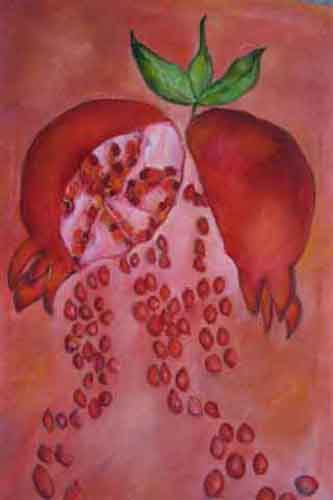

July 2016
When looking for the confirmation of End Times in our Hologram ... I was guided to research Pomegranate. and immediately found Judaism where the pomegranate is associated with The Book of Exodus ... leaving ... and other related symbology.
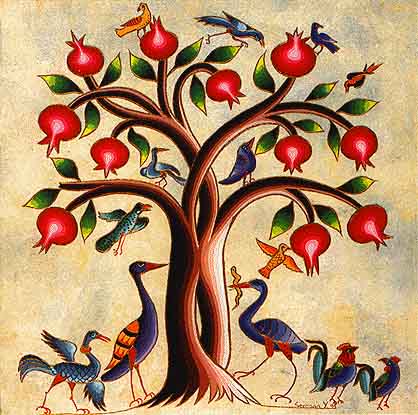
The pomegranate originated from Persia and has been cultivated in the Mediterranean region for several millennia. Carbonized exocarp of the fruit has been identified in Early Bronze Age levels of Jericho, as well as Late Bronze Age levels of Hala Sultan Tekke on Cyprus and Tiryns. Mesopotamian cuneiform records mention pomegranates from the mid-Third millennium BC onwards.
Pomegranates were extensively grown in South China and in Southeast Asia, whether originally spread along the route of the Silk Road or brought by sea traders.
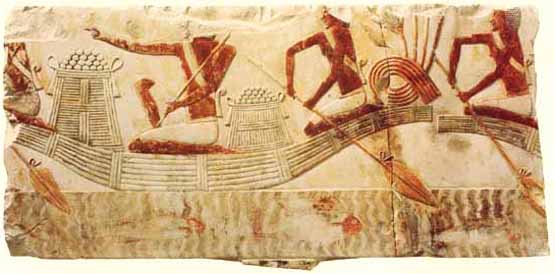
In ancient Egypt the pomegranate was considered to be a medicinal plant because of its therapeutic and vermifuge properties, and it was also used in funerary ceremonies. Pomegranates were also depicted in Egyptian tombs in 2500 BC, they were mentioned in the inscriptions of Tutmosi I (1547 BC), symbols of the pomegranate fruits were also found in the tomb of Ramses IV (1145 BC).
A large, dry pomegranate was found in the tomb of Djehuty, the butler of Queen Hatshepsut.
The wild pomegranate did not grow natively in the Aegean area in Neolithic times. It originated in eastern Iran and came to the Aegean world along the same cultural pathways that brought the goddess whom the Anatolians worshipped as Cybele and the Mesopotamians as Ishtar.
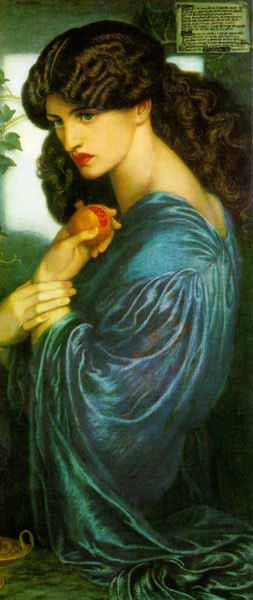
The myth of Persephone, the chthonic goddess of the Underworld, also prominently features the pomegranate. In one version of Greek mythology, Persephone was kidnapped by Hades and taken off to live in the underworld as his wife. Her mother, Demeter (goddess of the Harvest), went into mourning for her lost daughter and thus all green things ceased to grow.
Zeus, the highest ranking of the Greek gods, could not leave the Earth to die, so he commanded Hades to return Persephone. It was the rule of the Fates that anyone who consumed food or drink in the Underworld was doomed to spend eternity there. Persephone had no food, but Hades tricked her into eating four pomegranate seeds while she was still his prisoner and so, because of this, she was condemned to spend four months in the Underworld every year.
During these four months, when Persephone is sitting on the throne of the Underworld next to her husband Hades, her mother Demeter mourns and no longer gives fertility to the earth. This became an ancient Greek explanation for the seasons. Dante Gabriel Rossetti's painting Persephona depicts Persephone holding the fatal fruit. It should be noted that the number of seeds that Persephone ate varies, depending on which version of the story is told. The number of seeds she is said to have eaten ranges from three to seven, which accounts for just one barren season if it is just three or four seeds, or two barren seasons (half the year) if she ate six or seven seeds. There is no set number.
The pomegranate also evoked the presence of the Aegean Triple Goddess who evolved into the Olympian Hera, who is sometimes represented offering the pomegranate, as in the Polykleitos' cult image of the Argive Heraion. According to Carl A. P. Ruck and Danny Staples, the chambered pomegranate is also a surrogate for the poppy's narcotic capsule, with its comparable shape and chambered interior. On a Mycenaean seal illustrated in Joseph Campbell's Occidental Mythology 1964, figure 19, the seated Goddess of the double-headed axe (the labrys) offers three poppy pods in her right hand and supports her breast with her left. She embodies both aspects of the dual goddess, life-giving and death-dealing at once.
The Titan Orion was represented as "marrying" Side, a name that in Boeotia means "pomegranate", thus consecrating the primal hunter to the Goddess.
Other Greek dialects call the pomegranate rhoa; its possible connection with the name of the earth goddess Rhea, inexplicable in Greek, proved suggestive for the mythographer Karl Kerenyi, who suggested that the consonance might ultimately derive from a deeper, pre-Indo-European language layer.
In the 6th century BC, Polykleitos took ivory and gold to sculpt the seated Argive Hera in her temple. She held a scepter in one hand and offered a pomegranate, like a royal orb, in the other. "About the pomegranate I must say nothing," whispered the traveller Pausanias in the 2nd century, "for its story is something of a mystery."
In the Orion story we hear that Hera cast pomegranate-Side (an ancient city in Antalya) into dim Erebus - "for daring to rival Hera's beauty", which forms the probable point of connection with the older Osiris/Isis story.
Since the ancient Egyptians identified the Orion constellation in the sky as Sah the "Soul of Osiris", the identification of this section of the myth seems relatively complete. ['Sah' reminds me of the name Sarah].
Hera wears, not a wreath nor a tiara nor a diadem, but clearly the calyx of the pomegranate that has become her serrated crown. The pomegranate has a calyx shaped like a crown. In Jewish tradition it has been seen as the original "design" for the proper crown. In some artistic depictions, the pomegranate is found in the hand of Mary, mother of Jesus.
In modern times the pomegranate still holds strong symbolic meanings for the Greeks. On important days in the Greek Orthodox calendar, such as the Presentation of the Virgin Mary and on Christmas Day, it is traditional to have at the dinner table "polysporia", also known by their ancient name "panspermia," in some regions of Greece. In ancient times they were offered to Demeter and to the other gods for fertile land, for the spirits of the dead and in honor of compassionate Dionysus. When one buys a new home, it is conventional for a house guest to bring as a first gift a pomegranate, which is placed under/near the ikonostasi (home altar) of the house, as a symbol of abundance, fertility and good luck. Pomegranates are also prominent at Greek weddings and funerals. When Greeks commemorate their dead, they make kollyva as offerings, which consist of boiled wheat, mixed with sugar and decorated with pomegranate. It is also traditional in Greece to break a pomegranate on the ground at weddings and on New Years. Pomegranate decorations for the home are very common in Greece and sold in most homegoods stores.
At the times of ancient Romans, brides adorned their hair with small branches of pomegranate, as a symbol of richness and fertility.
During Christian times the pomegranate became the allegory of the Church which gathered its believers.
Painters of the renaissance put a pomegranate in the hand of the baby Christ as a symbol of the new life offered to humanity. Pliny the Elder called it Malum Punicum: a clear allusion to its probable Phoenician origin.
In the course of the 1400s the pomegranate is represented in many artworks, paintings, sculptures and decorative arts.
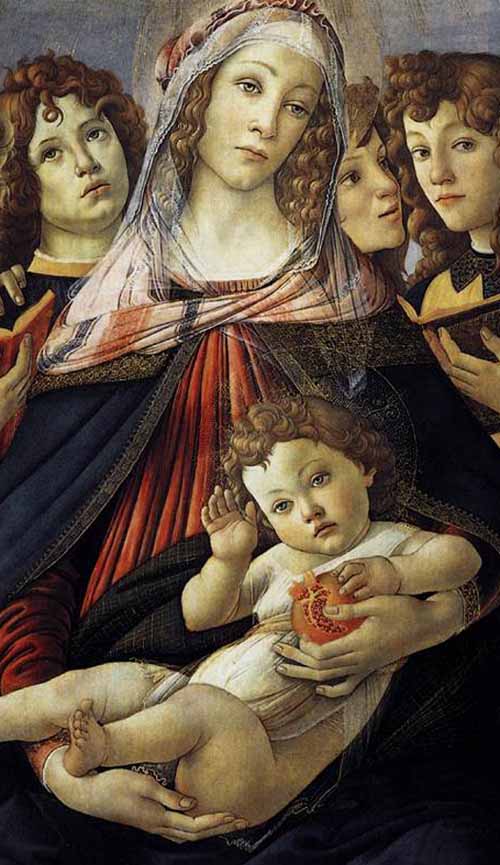

The fruit, broken or bursting open,
is a symbol of the fullness of his suffering and resurrection.

The red frequency refers to the physical plane of conscious experience. 'Blue' references higher frequency of thought and consciousness, into the light. Blue grapes symbolically found in many art works represent DNA evolving. Blue apples represent knowledge evolving to higher frequency, navy blue or the collective sea of consciousness creation, Sacred Geometry, SG or Stargates. 'Blue Apples' also relate to an optical phenomenon that occurs at midday (12:00) on January 17 when the sun shines through a stained-glass window depicting Jesus Raising Lazarus from the Dead, in the church at Rennes Le Chateau, linked to the bloodline stories of Mary Magdalene and Jesus. Orbs of bluish light appear on the church furnishings before stopping, then fading, on the altar with its bas-relief of Mary Magdalene kneeling in prayer with a skull at her knees (consciousness).
The ancient city of Granada in Spain was renamed after the fruit during the Moorish period. Spanish colonists later introduced the fruit to the Caribbean and Latin America, but in the English colonies it was less at home: "Don't use the pomegranate inhospitably, a stranger that has come so far to pay his respects to thee," the English Quaker Peter Collinson wrote to the botanizing John Bartram in Philadelphia, 1762. "Plant it against the side of thy house, nail it close to the wall. In this manner it thrives wonderfully with us, and flowers beautifully, and bears fruit this hot year. I have twenty-four on one tree... Doctor Fothergill says, of all trees this is most salutiferous to mankind."
The pomegranate had been introduced as an exotic to England the previous century, by John Tradescant the elder, but the disappointment that it did not set fruit there led to its repeated introduction to the American colonies, even New England. It succeeded in the South: Bartram received a barrel of pomegranates and oranges from a correspondent in Charleston, South Carolina, 1764. Thomas Jefferson planted pomegranates at Monticello in 1771: he had them from George Wythe of Williamsburg.
According to the Qur'an, pomegranates grow in the gardens of paradise (55:068). According to Islamic tradition, every seed of a pomegranate must be eaten, because one can't be sure which aril came from paradise. The Prophet Mohammed is said to have encouraged his followers to eat pomegranates to ward off envy and hatred. The Qur'an also mentions (6:99, 6:141) pomegranates twice as examples of good things God creates.
In the Eastern Orthodox Church, pomegranate seeds may be used in kolyva, a dish prepared for memorial services, as a symbol of the sweetness of the heavenly kingdom.
In decorative arts the symbol of pomegranate is very frequent, such as in case of the art of fabrics and in the art of pottery. Frequently used as a symbol of brotherhood and union, from the East to the West, pomegranate is the symbol of fertility and posterity, symbols which are well represented by the image and structure of pomegranate.
In the course of centuries, this particular fruit inspired many legends in many cultures and traditions. In India it is said the fruit of pomegranate is useful as a remedy for sterility, whereas in Turkey brides are used to throw a fruit of pomegranate on the ground and believe they will bear as many children as the grains coming out from the broken fruit.
Pomegranate is displayed on coins from the ancient city of Side, Pamphylia.
Pomegranate cultivation has a long history in Turkey, where decayed pomegranates date to 1000 BC.
It is the official logo of many cities in Turkey.
In Dalmatia a legend suggest to the bridegroom to move a plant of pomegranate from the garden of his father-in-law to his own.
Pomegranates can be found in Israel Regardie's first work A Garden of Pomegranates published prior to his entering Stella Matutitina - Hermetic Order of the Golden Dawn. Regardie was one of the first adepts to truly bring Qabbalah and the Golden Dawn system into the US. His writings and teachings provide much of the foundation for modern Western occultism.
In the book The Magus of Strovolos, Daskalos, a metaphysical healer and mentor from Cypress, discusses exomatosis (astral projection) and how Jesus taught his disciples the process of calming the mind and projecting out of body while laying in a pomegranate field.
Native Americans used the juice of pomegranate as a remedy for sterility.
Today in Africa the skin of the fruit is used to tan leather.
The pomegranate is the symbol and heraldic device of the city of Granada in Andalusia, Spain.
Pomegranate is one of the symbols of Armenia, representing fertility, abundance and marriage.
Pomegranate juice is used for natural dyeing of non-synthetic fabrics.
Although not native to China, Korea or Japan, the pomegranate is widely grown there and many cultivars have been developed. It is widely used for bonsai because of its flowers and for the unusual twisted bark that older specimens can attain.
Balaustines, the red rose-like flowers of the pomegranate, taste bitter and may be used as an astringent in folk medicine.
The term "balaustine" (Latin: balaustinus) is also used for a pomegranate-red color.
In Mexico, pomegranate seeds are an essential ingredient of chiles en nogada, a favored food symbolizing the red component of the national flag.
Kandahar is famous in Afghanistan for its high quality pomegranates.
Pomegranate finally reveals its powerful anti-aging secret Science Daily - July 11, 2016

Are pomegranates really the superfood that will counteract aging? Scientists have discovered that a molecule in pomegranates, transformed by microbes in the gut, enables muscle cells to protect themselves against one of the major causes of aging. In animals, the effect is nothing short of amazing. Clinical trials are underway.